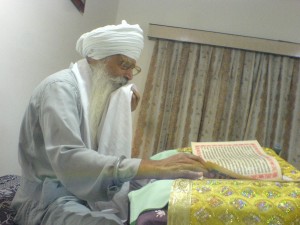 A Gursikh reading Gurbani does so in a “shudh” or correct manner when Gurbani is read with the correct pauses (bisraams) and “bindeeyaan” (a grammatical tool used to indicate nasal sounds and when certain letters such as “sussaa” should be pronounced in a secondary way). It is much easier for someone listening to the paath to understand when the paath is read correctly.
A Gursikh reading Gurbani does so in a “shudh” or correct manner when Gurbani is read with the correct pauses (bisraams) and “bindeeyaan” (a grammatical tool used to indicate nasal sounds and when certain letters such as “sussaa” should be pronounced in a secondary way). It is much easier for someone listening to the paath to understand when the paath is read correctly.
The Jatha believes that Gurbani should not be just read how it is written. There are some words that are spelled the same but adding a bindi or nasal sound changes the meaning. One of these words appears on ang 137 in the pangti: ਨਾਵੈ ਧਉਲੇ ਉਭੇ ਸਾਹ ॥ The word ਸਾਹ here means breath while the same word appears spelled the exact same way on ang 855 ਨਾਨਕ ਇਹੁ ਅਚਰਜੁ ਦੇਖਹੁ ਮੇਰੇ ਹਰਿ ਸਚੇ ਸਾਹ ਕਾ. In the second pangti the word ਸਾਹ means king and is pronounced with a bindi like ਸ਼ਾਹ. It would be incorrect to pronounce it as ਸਾਹ as it would change the meaning.
Other examples include ਮਹਲਾ ੧, ਮਹਲਾ ੨, ਮਹਲਾ ੩, ੪, ੫ we read this as ਮਹਲਾ ਪਹਿਲਾ, ਦੂਜਾ, ਤੀਜਾ, ਚੌਥਾ, ਪੰਜਵਾ) and not as ਮਹਲਾ ਇੱਕ, ਮਹਲਾ ਦੋ, ਮਹਲਾ ਤਿੰਨ, ਮਹਲਾ ਚਾਰ, ਮਹਲਾ ਪੰਜ
For ਮ:੧ , ਮ:੨ , ਮ: ੩ we read it as ਮਹਲਾ ਪਹਿਲਾ, ਦੂਜਾ, ਤੀਜਾ. We do not read them as ਮੰਮਾ ਇੱਕ, ਮੰਮਾ ਦੋ, ਮੰਮਾ ਤਿੰਨ
An example from the English language is the word Sugar. Those that know the English language well know to pronounce it as shugar, and not as as sugar. Those that do not have any knowledge on the English language but can only read the language would pronounce it as sugar which is incorrect.
It is common for certain letters to have two unique sounds. For example, the Ghughaa letter in the word “Singh” is pronounced differently than the same letter in the word “Ghar” (home). In the same way, the letter “sussaa” is pronounced usually as “s” but sometimes it is also pronounced as “sh”.
There are banis such as Sidh Gosht which is a dialogue between Guru Nanak Dev Jee and Yogis. It defies common sense that Guru Nanak Dev Jee would speak to the Yogis while failing to pronounce the correct nasal sounds and while failing to consistently pronounce the “sussaa” letter correctly while speaking to the Yogis in their language, considering that the Yogis spoke with underneath “bindeeyaan” which included sometimes pronouncing the “s” sound as “sh”.
Bhai Randhir Singh was strongly in favour of not reading Gurbani “as written”. In his book “Gurbani diyaan Laga Matra dee Vilakhanta”, he wrote several times about the need to add the correct nasal sounds and “bindeeyaan” to words that do not have them.
Other famous Gursikhs in the Panth such as Sant Gurbachan Singh Bhindrawale advocated the usage of bindia as well and did not read Gurbani simply as it is written. He taught his students where to add nasal sounds, adhaks, tippia etc. Evidence of this can be found in his book Gurbani Paat Darshan/Darpan.
To read Gurbani as it is written defies common sense in many cases. For example in the shabad:
ਠਾਕੁਰੁ ਲੇਖਾ ਮਗਨਹਾਰੁ ॥
His Lord and Master shall ask for his account.
The word ਮਗਨ means absorbed but in this line that word would not make any sense. The word ਮੰਗਨ with a tippi means to ask and that is the word that makes sense in this line. So to add bindia, nasal sounds, tippia, adhakhs is common sense in many cases in order for Gurbani to be pronounced correctly.